Fat is one of the three macronutrients (“macros”). Not only is this macronutrient essential for life to exist, but consuming healthy fats in the right quantity is crucial for optimal health as well.
On a keto or low-carb diet, it is particularly important to choose the right types of fats since it will be your primary energy source. To set you up for success, we put together a guide with everything you need to know about good and bad fats:
- What is fat?
- Saturated fat vs. unsaturated fat: what’s the difference?
- Types of dietary fat — definition, examples, and benefits
- Fatty acid chain length and its importance
- What kinds of fat should you eat?
- Good fats list
- The best fats for cooking and baking
- Fats to avoid
- The key differences between good and bad fats
- How much of each fat should you eat?
- Five healthy fat tips for keto success
What is Fat and Why is it Important?
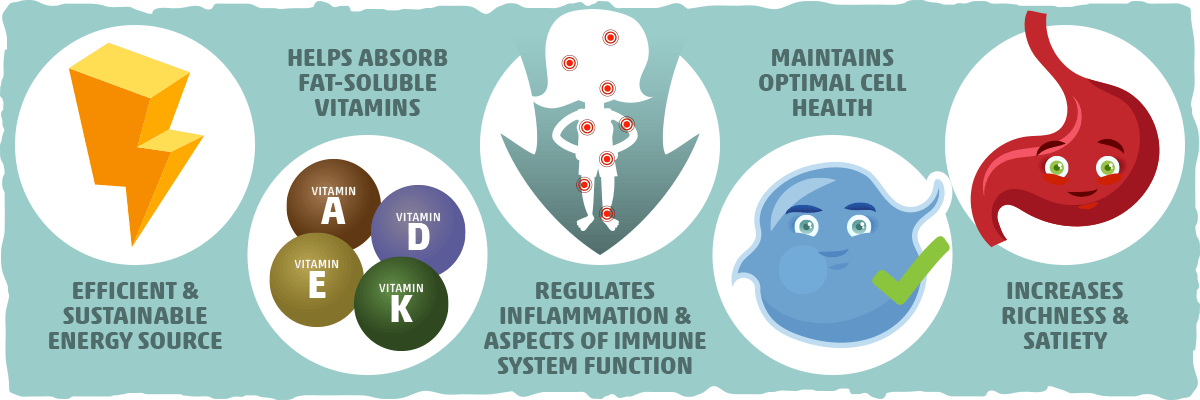
Fat is found in varying quantities in all foods, from fatty meats like bacon and short ribs to low-fat leafy greens like lettuce and spinach. This macro is so predominant in nature because it is an essential component of all cell membranes — and without a membrane, cells (and life as we know it) simply cannot exist.
Although its main function is to provide the building blocks for our cell membranes, fat plays a number of other important roles, including:
- Providing you with an efficient and more sustainable energy source than sugar
- Helping you absorb the fat-soluble vitamins A, D, E, and K
- Regulating inflammation and other aspects of immune system function
- Maintaining optimal cell health (improving cell communication, protecting the cell from invaders, etc.)
- Increasing the richness and satiety experienced from eating the food
The fat in food — also referred to as dietary fat — is primarily found in triglyceride form. Each triglyceride contains a glycerol molecule attached to 3 fatty acid chains that are made up of carbon and hydrogen atoms.
In the context of dietary fat, the terms “fatty acids,” “triglycerides,” and “fat” are used interchangeably to refer to the fatty acids in the triglycerides, and the effects these fatty acids have on our health.
The fatty acids are classified by the types of bonds they contain between the carbons in their chains, as well as the length of their chains.
To help us put these abstract concepts together, let’s take a look at the fatty acids found in this example of a triglyceride:
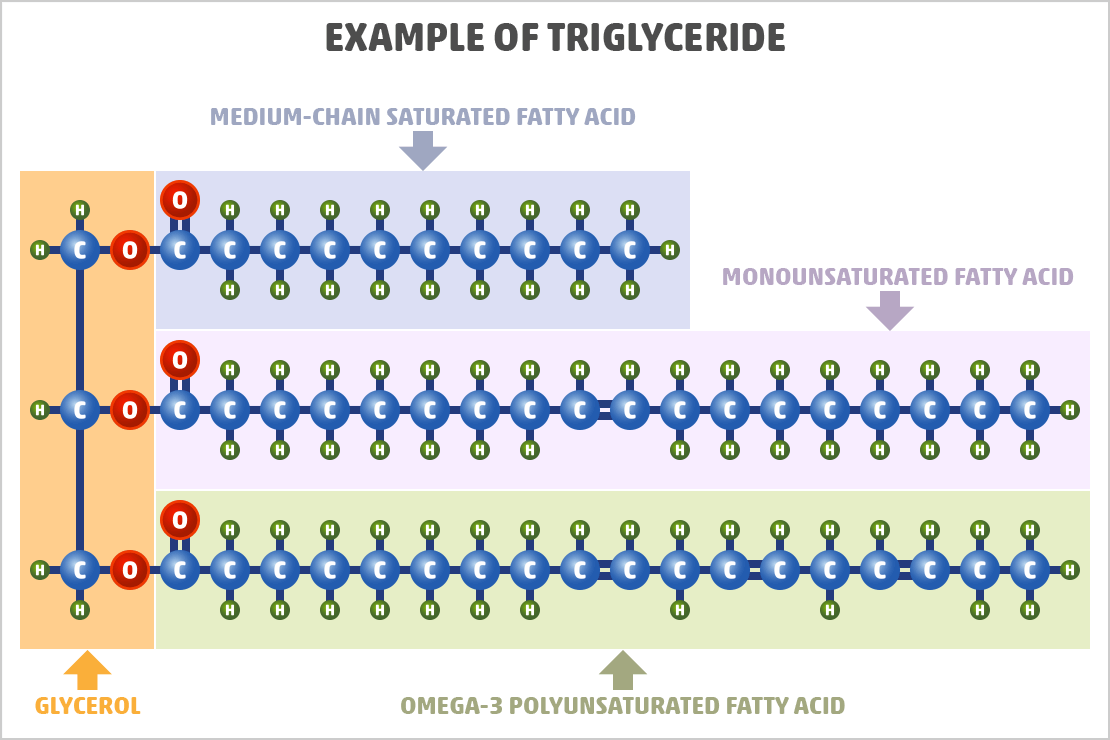
Here you’ll find a medium-chain fatty acid (commonly found in MCT oil), a monounsaturated fatty acid (commonly found in olive oil), and an omega-3 fatty acid (that is found in flaxseeds and chia seeds). Although they all fall under the category of dietary fat, each one has different health effects because of their variations in chain length and carbon-carbon bonds.
Saturated Fat vs. Unsaturated Fat: What’s the Difference?
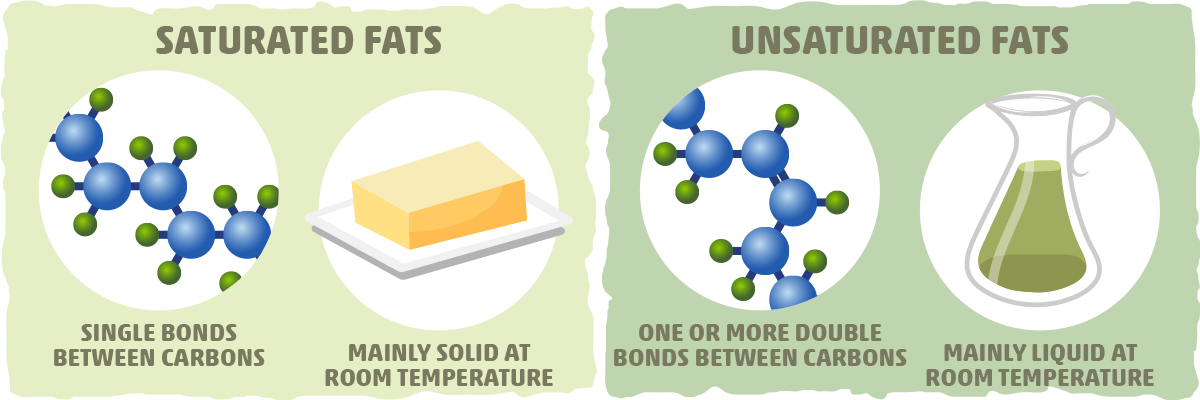
All of the natural fats we eat contain a combination of saturated and unsaturated fatty acids. Knowing the difference between the two is crucial to our understanding of healthy fat intake.
Deciphering between the two is relatively simple. Unsaturated fats have at least one carbon-carbon double bond while saturated fats have only carbon-carbon single bonds.
Put in another way, saturated fats are “saturated” with hydrogen atoms, while unsaturated fats do not have the maximum amount of hydrogen atoms a fatty acid can have, making them “unsaturated.”
Both types of fats are found in virtually every food we eat. Most plant foods, however, contain primarily unsaturated fats while animal fats (and some tropical oils) usually consist of a higher quantity of saturated fats.
Butter, lard, coconut oil, and tallow, for example, are predominantly made of saturated fatty acids. In contrast, common cooking oils like olive oil and canola oil are almost exclusively unsaturated.
A simple way to assess whether a natural fat/oil is mostly saturated or unsaturated is to see if it is solid or liquid at room temperature. Solid indicates a higher saturated fat content, while liquid suggests the oil is higher in natural unsaturated fats.
However, deciphering unsaturated from saturated fats is only the tip of the fatty acid iceberg. With each variation in a fatty acid chain — whether it’s in the chain length, number of carbon-carbon double bonds, and/or the type of double bonds — there will be a subsequent change in the chemical properties of the fatty acid and how it affects our health.
For this reason, it is helpful to understand the subcategories of fatty acids, including polyunsaturated, monounsaturated, saturated, and trans fats, as well as short-, medium-, and long-chain fatty acids.
The Types of Fat — Definitions, Examples, and Benefits
Polyunsaturated, Monounsaturated, and saturated fats are the primary sources of dietary fat. Each one is found in varying quantities in different foods. You’ll also encounter both natural and artificial trans fat in small amounts, and it’s helpful to know the difference.
We will decode the language of dietary fat and what this means for your diet and health below. Here are the main types of fat and their subgroups that we will learn about:
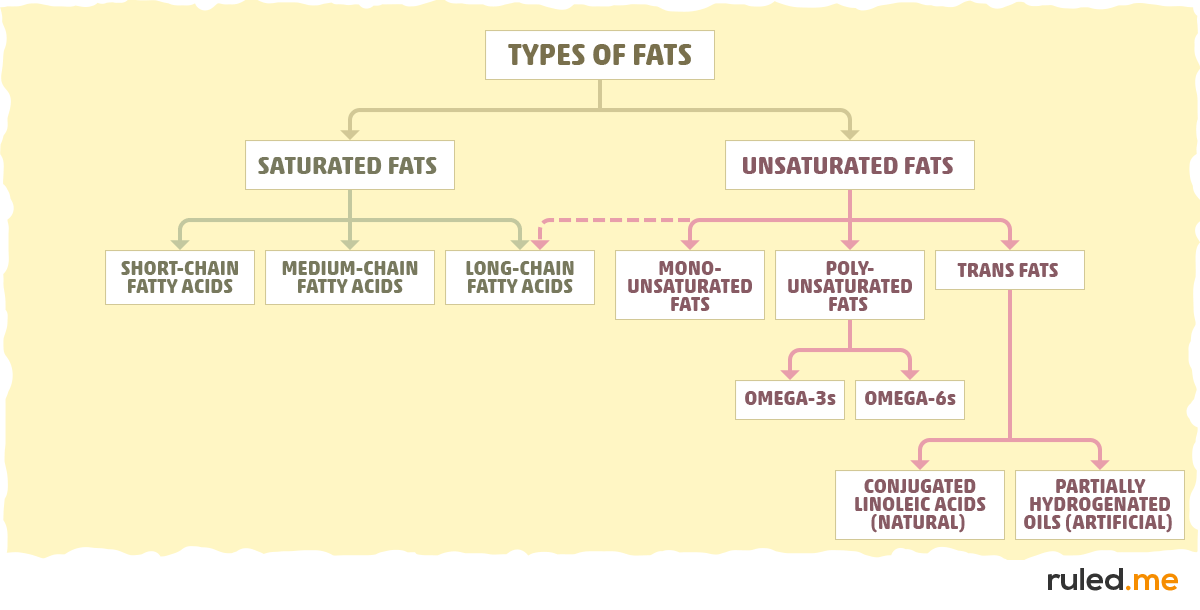
Saturated Fats
Saturated fats don’t have any double bonds between the carbons in their chains. They are “saturated” with hydrogen and are typically solid at room temperature.
Most saturated fats come from animal sources, including steak, bacon, butter, and eggs. However, you’ll find saturated fats in tropical plants as well, such as coconut oil, palm oil, and cocoa butter.
The saturated fatty acids in these foods are typically categorized based on chain length. We will learn more about each category — short-chain, medium-chain, and long-chain — in the next section.
The most common saturated fat found in our diets is a long-chain fatty acid called palmitic acid:
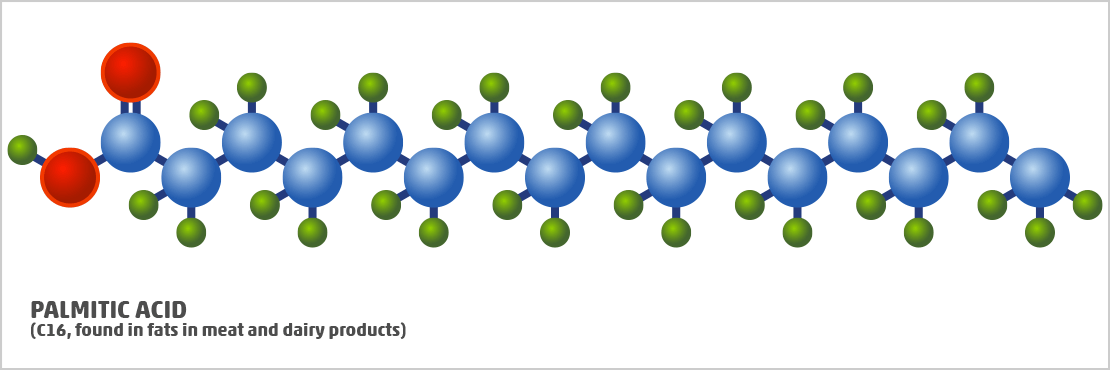
Despite the common assumption that saturated fats cause high cholesterol, clogged arteries, poor heart health and a host of other health problems, the current evidence suggests that this is not true.
In fact, there are many benefits of including healthy saturated fats in your low carb or keto diet. Saturated fat can help optimize cholesterol levels, boost cellular integrity, and increase ketone production and fat burning, among other benefits you can learn about here.
That being said, it is also important to know that eating high amounts of saturated fats have the potential to worsen cholesterol levels in a small subset of the population. Most people, however, will benefit from consuming saturated fat as a part of their low-carb or keto diet. For more information on this topic, check out our article on keto and cholesterol.
Monounsaturated Fats
Monounsaturated fats, also referred to as MUFAs, have one double bond between the carbons in their fatty acid chains. Oils high in these fats are liquid at room temperature (because of the double bond).
MUFAs are commonly known as healthy fats and are undoubtedly deserving of this distinction. Many studies have linked them to wide-ranging health benefits, including improving cholesterol levels, increasing insulin sensitivity, reducing the risk of heart disease, and increasing longevity, among other benefits you can learn about here.
For optimal health, make sure you are getting plenty of monounsaturated fats. Healthy sources of these fats include extra virgin olive oil, avocados, macadamia nuts, dark meat chicken, and bacon.
The most common monounsaturated fatty acid you’ll find in food is oleic acid:
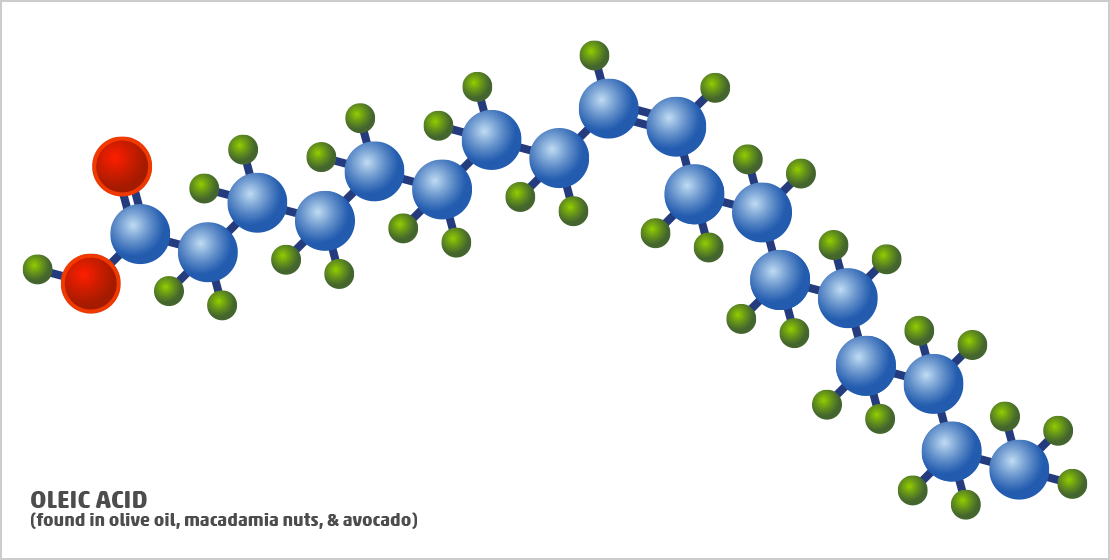
To learn more about monounsaturated fats, follow this link.
Polyunsaturated Fats
Polyunsaturated fats, also known as PUFAs, have more than one carbon-carbon double bond. Like MUFAs, they are liquid at room temperature.
PUFAs exist in our food as either omega–6 or omega–3 fatty acids, which are named for the position of the first double bond (from the methyl end) in their carbon chains. When consumed in sufficient amounts, these fats help improve heart health, optimize immune system function, reduce chronic inflammation, and reduce the risk of diabetes, among other benefits you can learn about here.
Healthy sources of omega-3 PUFAs — DHA and EPA in particular — include sardines, salmon, and mackerel. These omega-3 fatty acids can also be found in pasture-raised eggs, red meat, and dairy.
Although we can make DHA and EPA from alpha-linolenic acid, which is an essential omega-3 fatty acid found in some nuts and seeds, the conversion rate is so inefficient that it is best to get DHA and EPA directly from food.
Omega-6s are found in virtually all food you’ll eat on a low-carb diet including nuts, seeds, vegetables, meat, dairy, and eggs.
Most of these foods contain the essential omega-6 fatty acid, linoleic acid:
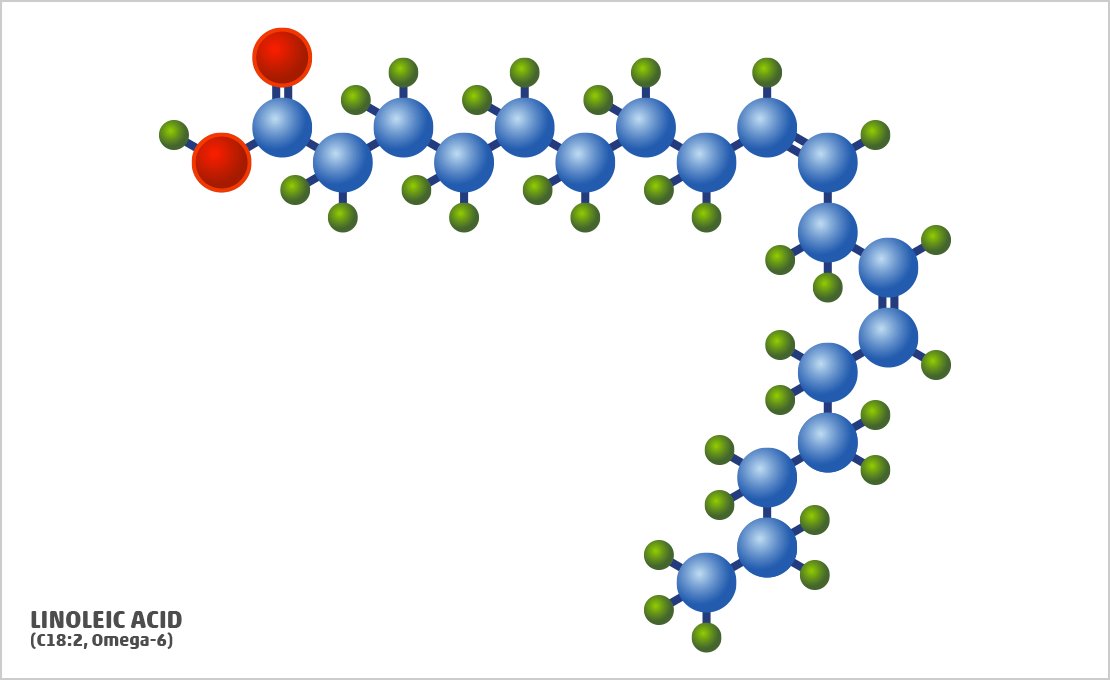
And here is what docosahexaenoic acid (DHA) — one of the most beneficial omega-3 fatty acids — looks like:
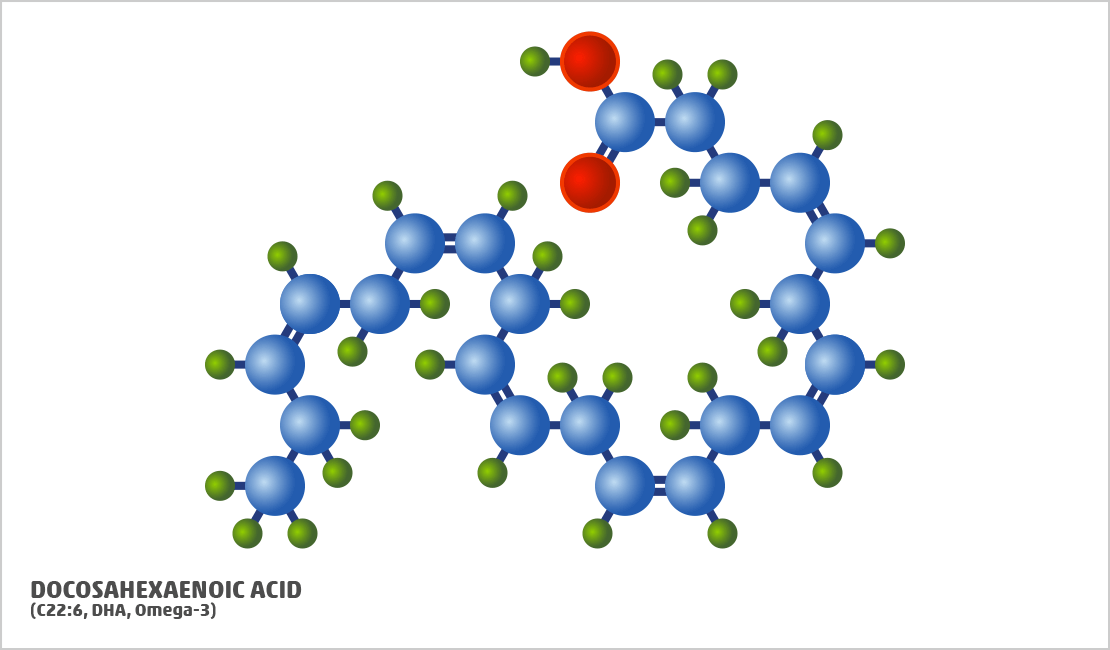
To learn more about polyunsaturated fats, follow this link.
Trans Fat — Natural vs. Artificial
Although natural and artificial trans fats both fall under the same “trans fat” category, they have different chemical structures and vastly different effects on our health.
Artificial trans fats are developed via a process called hydrogenation. This results in the creation of unsaturated fatty acids with one trans double bond:
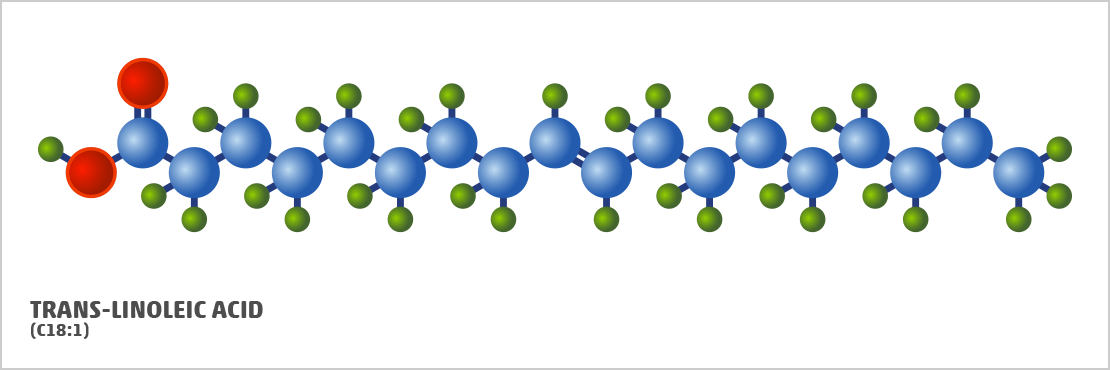
This simple change in bond type (from cis to trans) transforms what was once an unstable oil into a butter-like substance that has a longer shelf life.
Unfortunately, the health properties of these fats are dramatically altered as well — from a healthy fat to the only type of fat that is invariably bad for everyone’s health. You’ll find these toxic fats in any product with partially or fully hydrogenated oil on its ingredients list. Any food product with this ingredient should be avoided entirely.
The biological effects of natural trans fats, on the other hand, are much different. Research indicates that they may confer some benefits, including modest increases in fat loss.
These fats are commonly referred to as conjugated linoleic acids or CLAs, which represent a group of trans fats that are naturally formed during the process of linoleic acid digestion in ruminants like cows and sheep.
Here’s is an example of what conjugated linoleic acids look like:
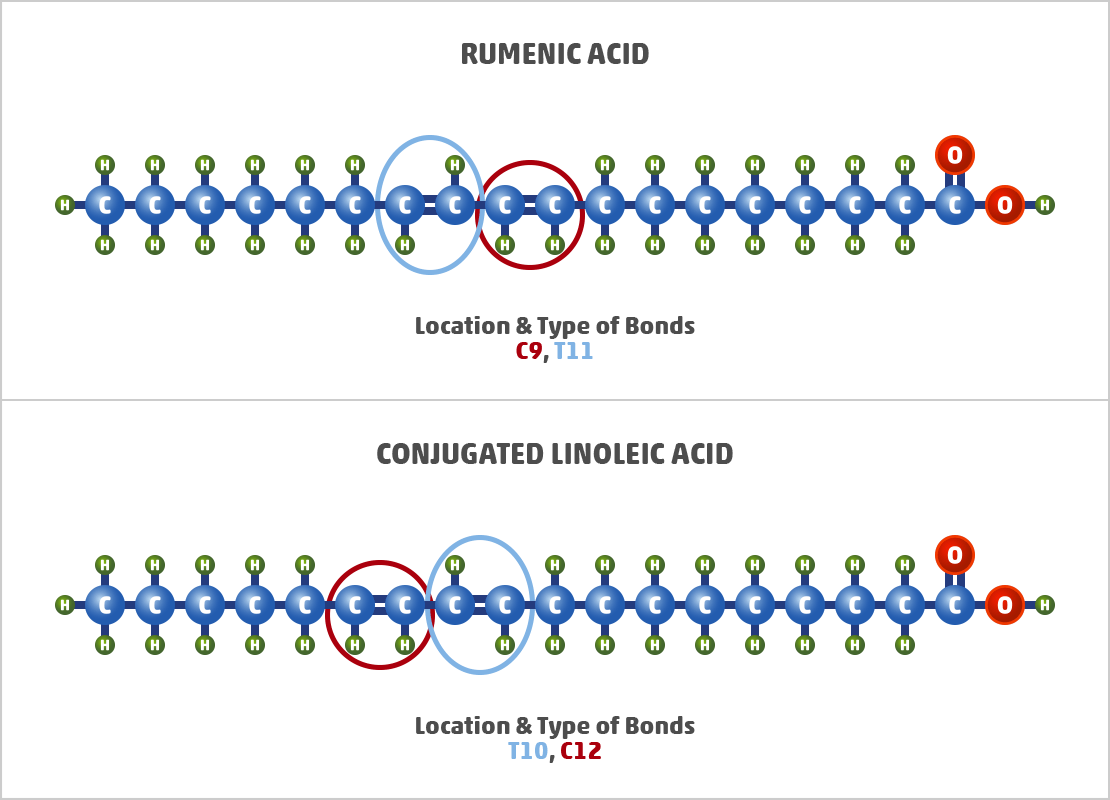
As you can see, these fats have both trans and cis double bonds in their carbon chains separated by one single bond. This is why we refer to these fatty acids as being “conjugated.”
These trans fats typically make up 2-5% of the fat in dairy products and 3-9% of the fat in beef and lamb. One of the most common types of CLA found in these foods is known as rumenic acid (the c9, t11 CLA pictured above).
You can find out more about both types of trans fat in our article on unsaturated fats.
Fatty Acid Chain Length
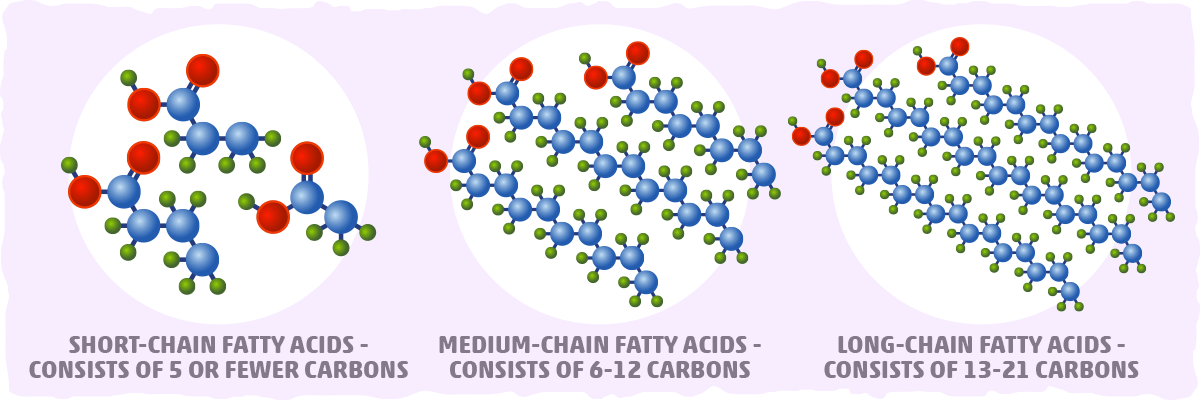
Fatty acids differ by length as well — often categorized from short to long. The length plays a role in how the fat is digested and metabolized by the body.
Short-chain Fatty Acids (SCFAs)
These fatty acids consist of five or fewer carbons. All dietary sources of SCFAs are saturated, none are unsaturated.
Acetate, propionate, and butyrate are the three most common forms of SCFAs. Butyrate is the most widely known and well-studied of the three, showing potential to improve gut health, prevent weight gain, and aid in weight loss.
Medium-chain Fatty Acids (MCFAs)
MCFAs are fatty acids that consist of 6 to 12 carbons. They are the primary component of the medium-chain triglycerides (MCTs) found in MCT oil and coconut oil. All dietary sources of MCFAs are saturated, none are unsaturated.
The MCFAs with 10 or fewer carbons enter the liver and are converted into ketones immediately after digestion, following a different digestive pathway than lauric acid (a 12-carbon MCFA) and long-chain fatty acids.
MCT oil supplements typically contain exclusively capric acid (C10) and caprylic acid (C8), while coconut oil is much more rich in lauric acid (C12). This fundamental variation changes how each MCFA source affects our health.
Coconut oil, for example, has been found to help optimize cholesterol levels, while MCT oil is praised for its ability to increase ketone levels more quickly and effectively.
If you’d like to learn more about the ketone-boosting benefits of MCFAs, check out our article on MCT oil.
For more information on coconut oil, click here.
Long-chain Fatty Acids (LCFAs)
LCFAs is the category for all of the fatty acids with 13 to 21 carbons, and there is a lot of them.
All polyunsaturated fats, monounsaturated fats, trans fats, and most of the saturated fats found in food are LCFAs.
In fact, most of the fats we consume, as well as the fatty acids found in cell membranes, are LCFAs. Examples of keto-friendly foods that contain these fatty acids include meat, poultry, fish, dairy, nuts, seeds, avocado, and olives.
What Types of Fat Should You Eat?
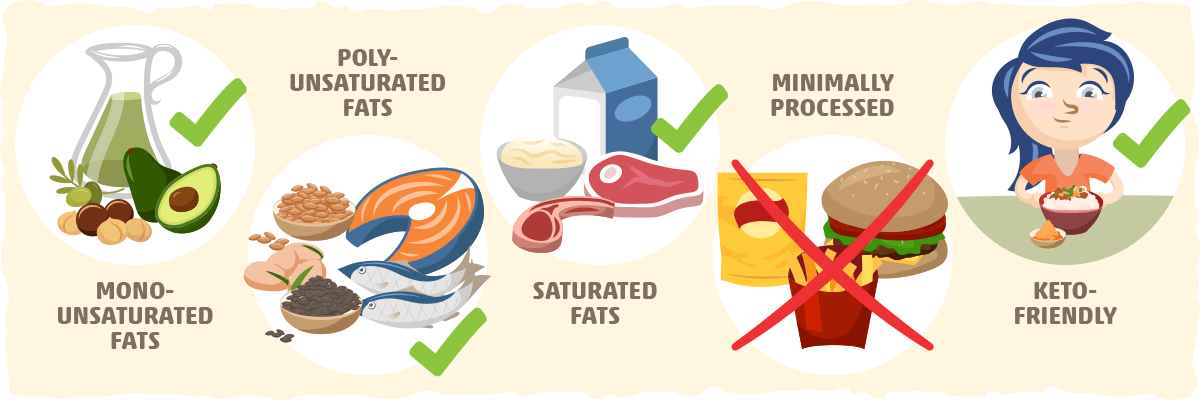
If the fat occurs naturally in food, has been minimally processed, and is keto-friendly, eat it. Put in another way, low-carb whole foods with monounsaturated, polyunsaturated, and/or saturated fatty acids in them should be your primary source of fat.
Despite the stigma surrounding saturated fat, studies have consistently failed to show a link between saturated fat and heart disease. According to recent research, saturated fats can actually be beneficial for health when consumed as a part of low-carb and ketogenic diets.
The same goes for monounsaturated and polyunsaturated fats as well — if you get it from keto-friendly high-quality foods, it is likely going to be a good source of fat for you.
However, as soon as the fat-rich item is heavily processed — like with refined vegetable oils and food-like products — it is better to avoid it and opt for minimally-processed, unrefined fat sources instead.
To give you a better idea of good vs. bad fats to consume and cook with on a low-carb or keto diet, we put together lists for each category.
Good Fats List: Healthy Choices for Low Carb and Keto Diets
Below you will find healthy sources of each fat type. Keep in mind that no food contains 100% saturated, monounsaturated, or polyunsaturated fat.
A healthy source of saturated fat, for example, will also come with some monounsaturated and polyunsaturated fats as well (except for MCT oil, which exclusively consists of medium-chain saturated fatty acids). If a listed item contains relatively high amounts of various types of fat, then you’ll find it under multiple lists.
When possible, opt for 100% grass-fed, pasture-raised beef, lamb, and dairy, as well as pasture-raised poultry, eggs, and pork. They will contain more health-promoting fats and beneficial nutrients than the conventional varieties of these foods.
Healthy Sources of Saturated Fat
Foods highest in saturated fat:
- Fatty cuts of beef and lamb
- Fatty cuts of pork
- Dark chicken meat and poultry skin
- Fatty cuts of duck
- High-fat dairy foods (cheese, heavy cream, and butter)
- Dark chocolate (with minimal sugar, a keto-friendly sugar alternative, or no sweeteners at all)
- Raw coconut butter (in moderation to limit net carb intake)
- Eggs
Fats/oils highest in saturated fat:
- MCT oil (for a ketone/energy boost)
- Coconut oil
- Cocoa butter
- Butter or ghee
- Palm oil or red palm oil (only purchase if sustainably produced in a way that doesn’t decimate the rainforest)
- Tallow
- Lard
- Duck fat
- Chicken fat
Healthy Sources of Monounsaturated Fat
Foods highest in monounsaturated fat:
- Macadamia nuts and homemade macadamia nut butter
- Olives
- Hazelnuts and sugar-free hazelnut butter
- Avocados
- Almonds and sugar-free almond butter
- Pecans and sugar-free pecan butter
- Peanuts and sugar-free peanut butter
- Duck legs
- Dark meat chicken
- Bacon
- Atlantic herring
Fats/oils highest in monounsaturated fats:
- High-oleic safflower/sunflower oil (best source of oleic acid)
- Extra virgin olive oil (best for high-heat cooking)
- Avocado oil (great for high-heat cooking)
- Macadamia nut oil
- Goose fat
- Duck fat
- Chicken fat
- Lard (great for high-heat cooking)
Healthy Sources of Polyunsaturated Fat
Best sources of DHA and EPA omega-3 fatty acids:
- Salmon
- Sardines
- Mackerel
- Rainbow Trout
- Sea Bass
- Algal oil (vegan-friendly option)
Best sources of alpha-linolenic acid (ALA) omega-3 fatty acid:
- Chia seeds
- Walnuts
- Flaxseeds
- Hemp seeds
Healthy sources of omega-6s*:
- Walnuts
- Sunflower seeds
- Pine nuts
- Bacon
- Peanuts
- Almonds
- Chicken thighs (with skin)
- Eggs
- Butter
- Hemp seeds
*Avoid vegetable and seed oils that are high in omega-6s (especially safflower oil, sunflower oil, soybean oil, cottonseed oil, and corn oil) – as well as processed foods that contain these oils.
Healthy Sources of CLA (Natural Trans Fats)
Foods highest in CLA:
- High-fat dairy products (e.g., butter, heavy cream, and cheese)
- Fatty cuts of beef
- Fatty cuts of lamb
Good Fats and Oils for Low Carb Cooking and Baking
When it comes to cooking and baking, we must be more cautious of the fats/oils we use. Some fatty acids are less stable and more prone oxidation than others. As the fatty acids in a fat/oil oxidize, they become toxic compounds that impair health after ingestion.
In general, fatty acids are more vulnerable to oxidation as their number of double bonds increase. The most unstable oils, for example, are ones high in polyunsaturated fats. For this reason, it is best to avoid using most vegetable and seed oils in cooking and baking.
In contrast, the most stable fats/oils — i.e., fats/oils that are good options for cooking — are high in saturated fats and/or monounsaturated fats and low polyunsaturated fats.
Although monounsaturated fats are less stable than saturated fats, studies show that high-MUFA oils, like avocado oil and extra virgin olive oils, are typically on par with coconut oil (which mostly consists of saturated fat). If the oil has naturally-occurring antioxidants — as is the case with extra virgin olive oil — this can help prevent the formation of toxic compounds as well.
After experimenting with many fats/oils, Martin Grootveld — a professor of bio-analytical chemistry and chemical pathology at De Montfort University, Leicester — found that the fatty acid composition of a cooking oil/fat should look something like this:
- Greater than 60% of saturated fats or monounsaturated fats
- More than 80% of the two combined
- Less than 20% of polyunsaturated fats
Below you’ll find a chart of common cooking fats/oils and how they rank.
Note: The following percentages represent an example of the typical distribution of fatty acids. The composition can vary a bit depending on the specific animal or plant that the fat/oil is derived from.
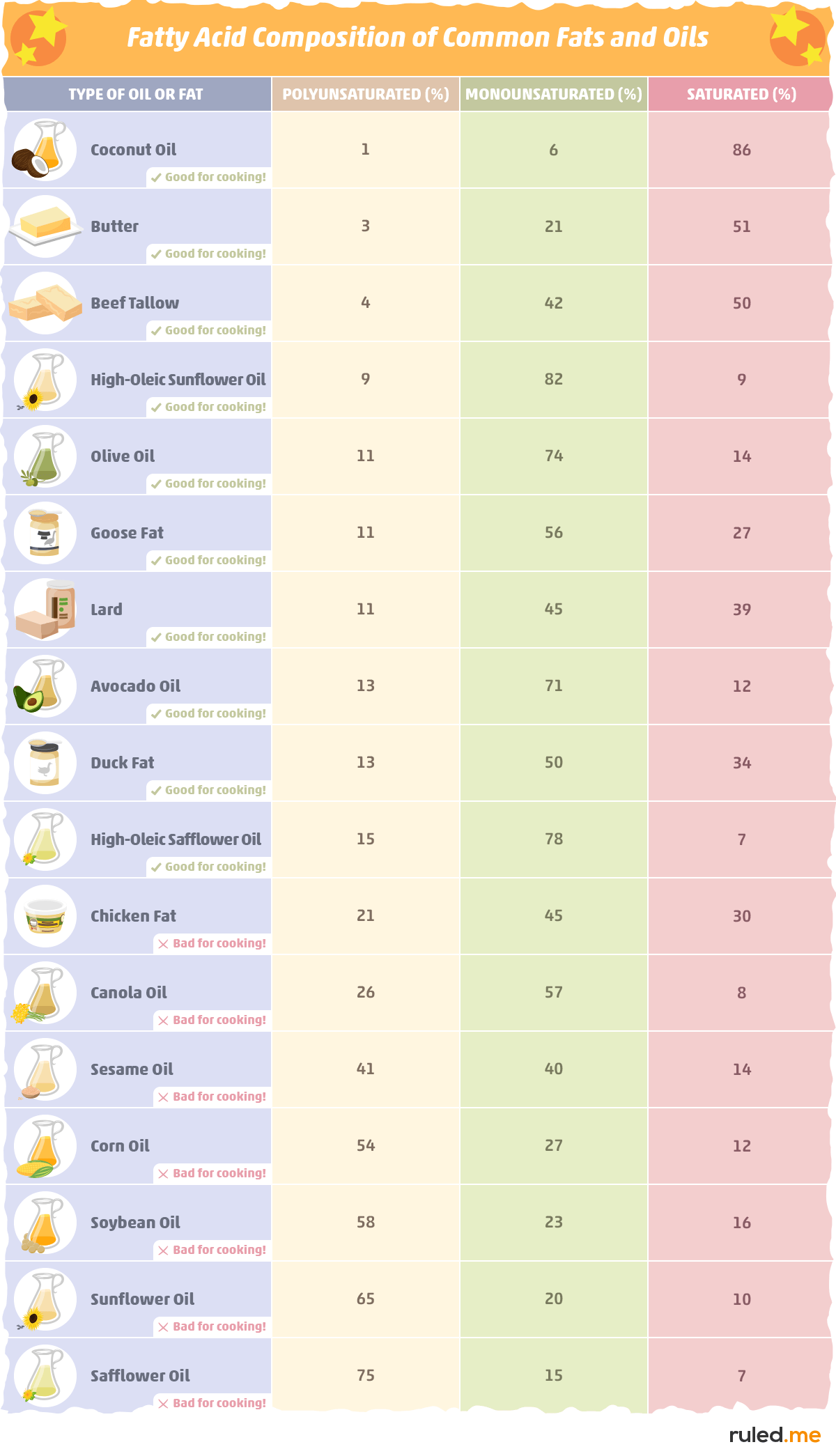
List of Healthy Fats and Oils for Cooking and Baking
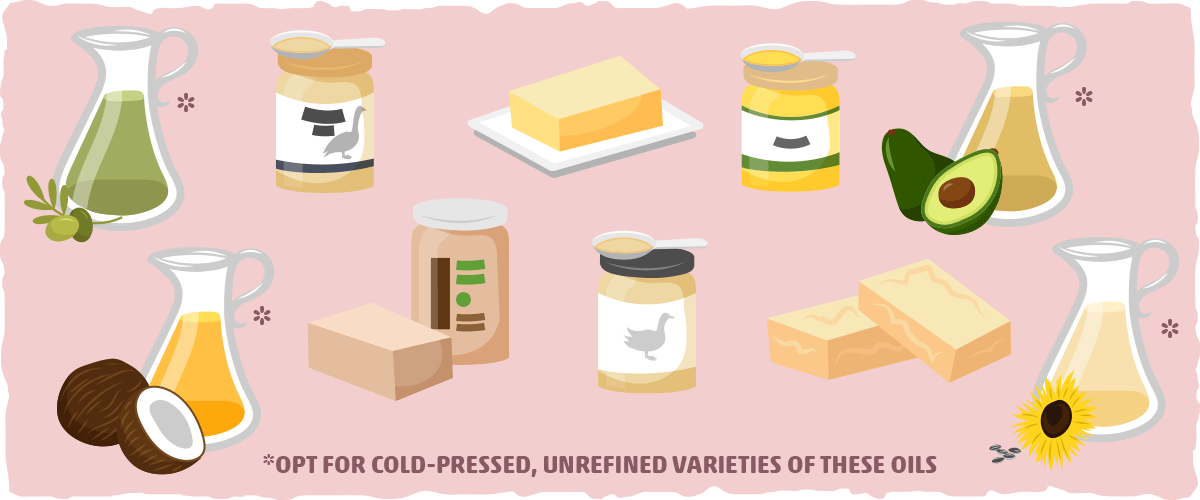
Given the information from the previous section, here is what we found to be the healthiest cooking fats for keto:
- Extra virgin olive oil*
- Coconut oil*
- Avocado oil*
- Lard
- Tallow
- Butter or Ghee
- Goose fat
- Duck fat
- High-oleic sunflower or safflower oil*
*opt for cold-pressed, unrefined varieties of these oils.
Bad Fats to Avoid
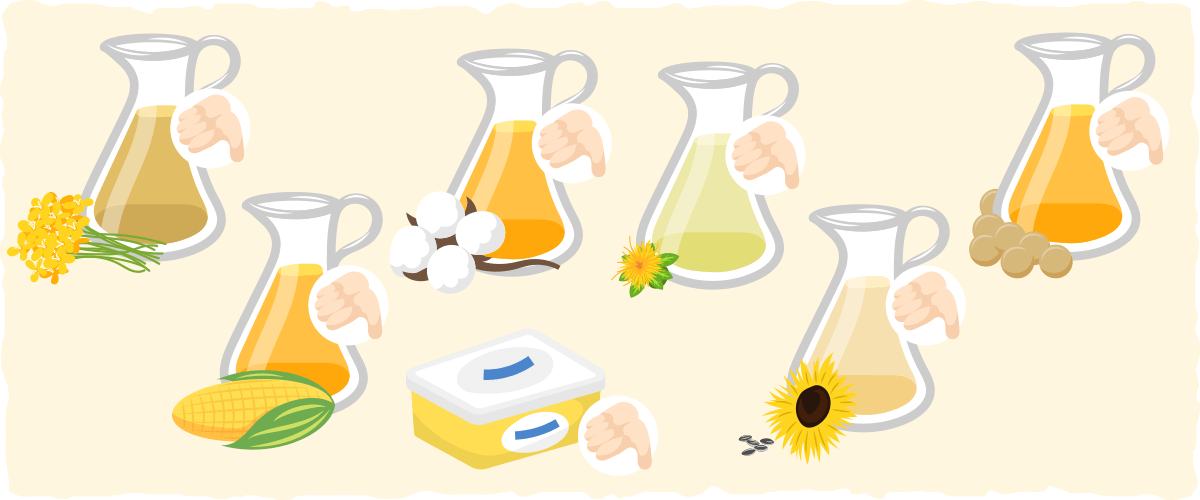
We recommend avoiding all partially hydrogenated oils and refined plant-based oils, such as safflower, sunflower, canola, corn, and soybean oil. Additionally, it is best to stay away from mayonnaise, margarine, and spreads that contain these oils.
Unlike fats found naturally in foods, vegetable and seed oils are highly refined products that don’t provide any nutritional value. They also tend to be extremely high in omega-6 fatty acids, which most of us get more of than we need from whole food sources.
List of Unhealthy Fats and Oils to Avoid
The following fat sources are so high in omega-6s and/or artificial trans fat that they have no place in any diet:
- Margarine
- All partially hydrogenated oils
- Corn oil
- Soybean oi
- Safflower oil
- Sunflower oil
- Cottonseed oil
- Canola oil
Healthy Fat Principles: The Difference Between Good and Bad Fats
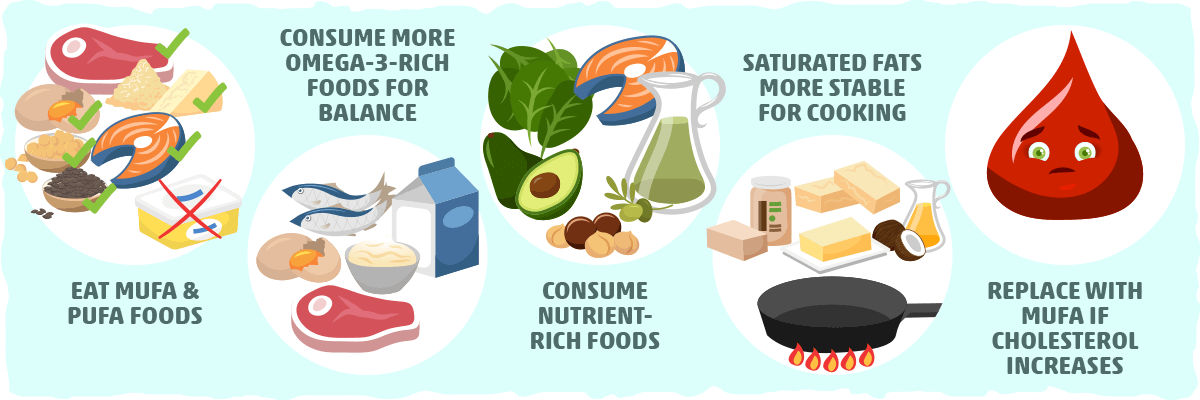
Inevitably, you’ll come across a fat or oil that isn’t mentioned throughout this article. In this case, it is crucial to understand the principles that set the good apart from the bad.
Here are the five key criteria that can help us decipher the healthier choice from the unhealthy option:
- Fatty acid composition. Foods, oils, and fats that are high in MUFAs are typically healthiest, followed by foods high in both MUFAs and saturated fatty acids. All omega-3 and omega-6 PUFAs should be consumed from minimally processed fish, meats, nuts, seeds, eggs, and cheese. Finally, all artificial trans fat should be avoided.
- Omega-6 to omega-3 ratio. On a low carb or keto diet, you’ll be getting plenty of omega-6s from fresh fish, eggs, meats, dairy, and whole plant foods, so it’s best to optimize for higher omega-3 foods. Consuming too many omega-6s and insufficient amounts of omega-3s can promote chronic inflammation and stimulate many of the mechanisms behind cancer, heart disease, obesity, and type 2 diabetes. Thus, it is best to cut out all high omega-6 oils and eat plenty of wild-caught fatty fish and pasture-raised eggs, meat, and dairy.
- Nutrient density optimization. The consumption of minimally processed foods has been emphasized throughout this article because they come with health-promoting nutrients along with their fats. Nutrient-dense whole foods should be the primary source of fat on any low-carb diet, and pure fats/oils should only be used to top off the fatty foods you are already consuming.
- Chemical stability when cooking. As mentioned earlier, saturated fats tend to be the most stable, and polyunsaturated fats are the most fragile. When cooking, it is best to use oils that are high in saturated and/or monounsaturated fats and very low in PUFAs.
- Individual response to specific fats. For a small subset of the population, increased saturated fat consumption can impair cholesterol levels. For these individuals, some of their saturated fat intake may need to be replaced by MUFAs and minimally processed PUFAs. If this small shift doesn’t help, it may be helpful to read through our article on keto and cholesterol.
Practical Takeaways: How Much of Each Fat Should You Eat for Optimal Health?
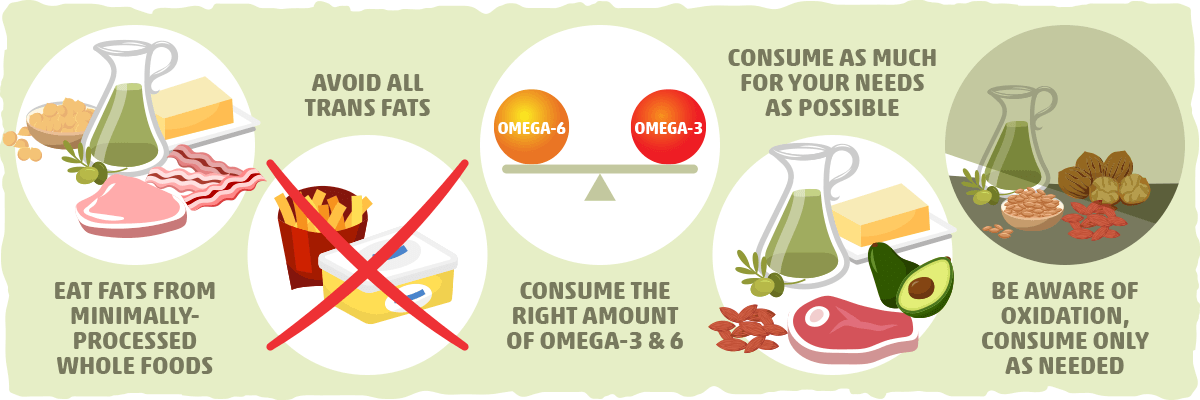
In general, your primary source of fat should come from minimally-processed foods. This will help you optimize your diet for other nutrients, such as fiber, vitamins, minerals, and other health-promoting components.
The pure fats/oils listed above should be used for cooking and increasing the fat content of your meal when needed but should not represent your primary source of calories.
There is no universally optimal intake level of polyunsaturated fat, monounsaturated fat, or saturated fat for keto dieters. The only fat that has any specific quantity attached to it is artificial trans fat – and that optimal intake level is zero grams.
When it comes to polyunsaturated fat intake, however, getting the right amount of omega-6s and omega-3s is crucial.
The World Health Organization recommends an omega-3 fatty acid intake of 0.5–2% of energy per day. The American Heart Association specifically recommends that we get at least two servings of omega-3-rich fish per week or 500 mg EPA + DHA per day.
Regarding omega-6 intake, a recent analysis conducted by the American Heart Association emphasizes the importance of consuming at least 5-10% of daily calories from omega-6 fatty acids.
That being said, more is not better when it comes to omega-3 and omega-6 consumption. Given the potential for oxidation and the lack of research supporting high levels of PUFA intake, it is likely best only to consume these fatty acids in quantities that meet your needs — not substantially more nor less.
In contrast to PUFAs, monounsaturated and saturated fats will represent the bulk of your calories on a low carb or keto diet. As long as you are eating the right amount to reach your goals and your overall health is improving, feel free consume as many of these fats from minimally processed foods as you’d like.
Putting It All Together — The Five Healthy Fat Tips for Keto Success
Altogether, we can distill the above recommendations into five healthy fat tips for optimal health:
- Get most of your fat from minimally processed high-fat foods. Only use pure fats/oils to supplement your meal rather than guzzling them down as your predominant fat source.
- Monounsaturated and saturated fats should represent the majority of your fat intake. To help you find out what your fat intake should be, try using our keto calculator.
- Meet your minimum intake requirements of omega-6 and omega-3s from whole foods. Consuming higher than sufficient amounts of either fatty acid type is not necessary for optimal health and may even be harmful.
- Avoid all partially hydrogenated oils and refined oils that are high in omega-6 fatty acids.
- Only cook with fats/oils that have more than 80% of monounsaturated + saturated fats and contain less than 20% of polyunsaturated fats. As an example, extra virgin olive oil, avocado oil, and coconut oil are two of the best options.
If you’d like to learn more about each type of fat and its benefits, check out these articles:
As with everything you eat, make sure you’re mindful of how much fat, protein, and carbs you need to achieve the results you want.
The easiest way to stay on the right track is by using our keto meal planning app. It will provide you with an endless eating plan full of keto recipes personalized to your goals and preferences.
Sources
- Which oils are best to cook with? — BBC
- The Cell: A Molecular Approach. 2nd edition. — NCBI
- Chapter 4 – Oxidative Stability and Shelf Life of Vegetable Oils — ScienceDirect
- Evaluation of Chemical and Physical Changes in Different Commercial Oils during Heating — Acta Scientific Nutritional Health
- The Importance of Fats in a Ketogenic Diet — Ruled.me
- Types of Fat — Harvard
- The Ketogenic Diet and Cholesterol — Ruled.me
- Short term effects of dietary medium-chain fatty acids and n-3 long-chain polyunsaturated fatty acids on the fat metabolism of healthy volunteers — NCBI